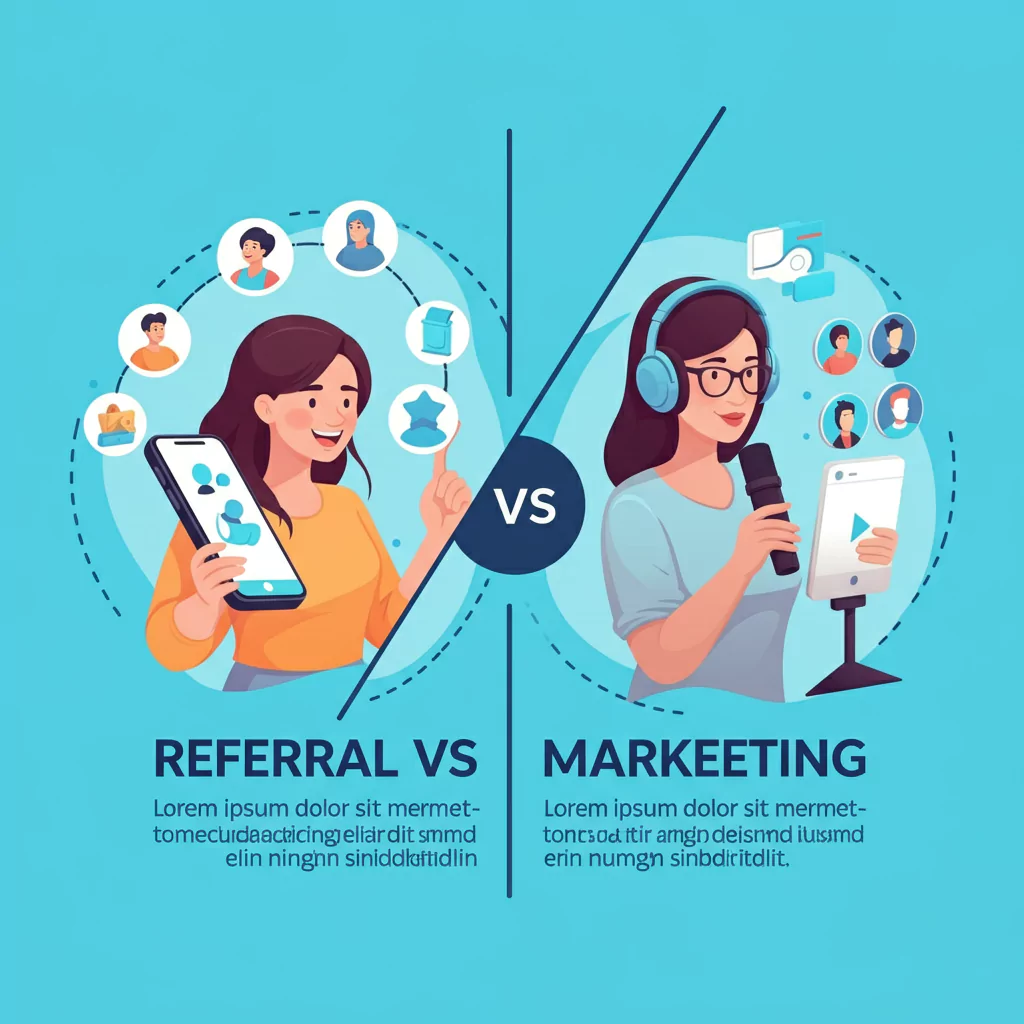Marketing budgets are tighter than ever, and every dollar needs to justify itself. Two strategies consistently spark debate in boardrooms: referral marketing and influencer marketing. Both promise strong returns, but they work in fundamentally different ways.
Referral marketing leverages your existing customers to bring in new ones through word-of-mouth recommendations. Influencer marketing partners with content creators who promote your brand to their established audiences. The question isn’t which strategy is better overall—it’s which one delivers superior ROI for your specific business goals and circumstances.
This comprehensive analysis will break down the costs, benefits, and real-world performance of both approaches. You’ll discover when each strategy shines, how to measure its effectiveness, and practical frameworks for deciding where to invest your marketing dollars.
Understanding Referral Marketing ROI
Referral marketing transforms satisfied customers into active promoters of your brand. The mechanism is straightforward: customers receive incentives for successfully referring new buyers, creating a mutually beneficial relationship.
The Cost Structure of Referral Programs
Referral marketing typically involves three main cost components:
Program setup and management include platform fees, integration costs, and ongoing administration. Most referral software solutions charge between $50-$500 monthly, depending on features and scale.
Referral rewards represent the largest expense. Common structures include cash payments ($10-$50 per successful referral), account credits (10-20% of purchase value), or product discounts. The key advantage: you only pay when a sale occurs.
Marketing the program requires investment in email campaigns, website integration, and customer communication to drive participation.
Measuring Referral Marketing Returns
The beauty of referral marketing lies in its trackability. Every referred customer can be directly attributed to the program, making ROI calculations straightforward.
Customer acquisition cost (CAC) through referrals typically ranges from $10-$50, significantly lower than most paid advertising channels. More importantly, referred customers often demonstrate higher lifetime value due to the trust inherent in personal recommendations.
Referral programs also generate compounding returns. Referred customers become potential referrers themselves, creating a multiplier effect that traditional advertising cannot match. A single successful referral can theoretically generate dozens of subsequent customers over time.
When Referral Marketing Excels
Referral marketing performs best for businesses with strong customer satisfaction and natural sharing potential. Service-based companies, subscription products, and high-consideration purchases often see exceptional results.
The strategy particularly shines when customers have existing networks of potential buyers. B2B software companies frequently achieve 20-30% of new acquisitions through referrals because business professionals naturally discuss tools and solutions with peers.
Analyzing Influencer Marketing ROI
Influencer marketing connects brands with content creators who have built engaged audiences around specific topics or lifestyles. The approach offers access to pre-qualified prospects but comes with different cost structures and measurement challenges.
Breaking Down Influencer Marketing Costs
Influencer partnerships involve several cost categories that vary dramatically based on creator tier and campaign scope.
Influencer fees represent the primary expense. Nano-influencers (1K-10K followers) might charge $10-$100 per post, while macro-influencers (100K-1M followers) command $1,000-$10,000 or more. Celebrity partnerships can reach six or seven figures.
Content production costs include product samples, creative briefs, content review, and sometimes additional production support. These expenses often add 20-30% to base influencer fees.
Campaign management encompasses influencer discovery, negotiation, relationship management, and performance tracking. Brands either invest internal resources or pay agencies $2,000-$10,000+ monthly for these services.
Calculating Influencer Marketing Returns

Measuring influencer marketing ROI requires sophisticated attribution methods. Unlike referral programs with direct tracking, influencer campaigns create awareness that may convert days or weeks later through different channels.
Direct response metrics include clicks, conversions, and revenue from tracking links or discount codes. However, these typically capture only 20-40% of total impact, as many customers research independently after seeing influencer content.
Brand awareness and engagement metrics provide additional value indicators. Reach, impressions, engagement rates, and brand mention sentiment contribute to long-term growth that’s harder to quantify immediately.
Influencer Marketing’s Competitive Advantages
Influencer partnerships excel at reaching new audiences and building brand credibility quickly. Unlike referral marketing, which relies on existing customer networks, influencers provide immediate access to thousands or millions of potential customers.
The strategy particularly benefits visual products, lifestyle brands, and companies targeting specific demographics. Beauty, fashion, fitness, and technology brands often achieve strong returns through influencer partnerships because content creators can demonstrate products authentically.
What makes influencer marketing particularly powerful is its alignment with buyer psychology in product marketing. Consumers are more likely to trust recommendations from individuals they admire or relate to, especially when product use is demonstrated in real-life scenarios. This taps into the emotional and social triggers that drive purchase decisions—such as aspiration, fear of missing out, and the desire for belonging—making influencer content more persuasive than traditional ads.
Influencer marketing also creates content assets that provide ongoing value. High-quality photos, videos, and testimonials from partnerships can be repurposed across owned marketing channels, extending the initial investment’s impact.
Comparing ROI Performance Across Industries
Different business models and industries see varying results from referral versus influencer marketing strategies.
E-commerce and Retail
E-commerce businesses often find that referral marketing delivers superior long-term ROI due to lower customer acquisition costs and higher lifetime value from referred customers. Amazon’s affiliate program and fashion brands like Outdoor Voices have built massive referral engines that generate consistent, cost-effective growth.
However, influencer marketing can drive rapid awareness and sales spikes for product launches or seasonal campaigns. Fashion and beauty e-commerce brands frequently use influencer partnerships to showcase new collections and drive immediate purchases.
Software as a Service (SaaS)
SaaS companies typically see exceptional referral marketing performance because satisfied customers naturally discuss business tools with colleagues. Dropbox famously grew from 100,000 to 4 million users in 15 months, primarily through referrals, offering extra storage space for successful recommendations.
Influencer marketing in SaaS requires careful creator selection, focusing on business leaders, entrepreneurs, and industry experts rather than traditional lifestyle influencers. When executed properly, it can effectively reach decision-makers who might never encounter referral opportunities.
Professional Services
Professional service providers—lawyers, consultants, agencies—often achieve the highest referral marketing ROI because personal recommendations carry enormous weight in trust-based industries. Clients naturally discuss service providers with peers facing similar challenges.
Influencer marketing works best when professional service providers can demonstrate expertise through educational content partnerships rather than direct promotional posts.
Hybrid Approaches and Strategic Combinations
The most sophisticated marketers don’t choose between referral and influencer marketing—they combine both strategies strategically.
Influencer-Driven Referral Programs
Smart brands recruit influencers as referral program advocates, combining the reach of influencer marketing with the performance-based costs of referral programs. Influencers promote referral codes or links, earning commissions only when followers make purchases.
This approach provides influencers with ongoing revenue potential while giving brands performance-based influencer partnerships. The strategy works particularly well with micro-influencers who prefer consistent, long-term relationships over one-time campaign fees.
Customer Advocacy Programs
Advanced referral programs identify customers with large social followings and provide them with enhanced benefits, essentially treating high-influence customers as micro-influencers. These advocates receive better rewards, exclusive access, and sometimes additional perks for creating content about their referrals.
The approach combines the authenticity of genuine customer advocacy with the reach potential of influencer marketing.
Measuring and Optimizing ROI Over Time
Both referral and influencer marketing require ongoing optimization to maximize returns.
Key Performance Indicators for Each Strategy
Referral marketing success metrics include referral rate (percentage of customers who refer others), conversion rate of referred prospects, average referral value, and program participation growth over time.
Influencer marketing KPIs encompass engagement rates, click-through rates, conversion rates, cost per acquisition, brand awareness lift, and content performance across different creator tiers.
Testing and Iteration Strategies
Successful referral programs test different reward structures, communication methods, and program mechanics. A/B testing reward amounts, timing of referral asks, and referral landing page designs can significantly impact performance.
Influencer marketing optimization involves testing different creator types, content formats, posting schedules, and call-to-action approaches. Brands should track which influencer characteristics correlate with higher conversion rates and audience quality.
Making the Strategic Choice for Your Business
The decision between referral and influencer marketing—or the balance between both—depends on several critical factors.
Consider referral marketing as your primary strategy if you have high customer satisfaction, natural sharing opportunities, and customers with relevant networks. The approach works best for businesses with repeat purchase potential and strong word-of-mouth characteristics.
Prioritize influencer marketing when you need rapid awareness building, access to new demographics, or visual content creation. The strategy suits businesses with photogenic products, lifestyle positioning, or specific target audience concentrations on social platforms.
Most importantly, consider your current customer base size. Referral marketing requires existing satisfied customers to generate momentum, while influencer marketing can jumpstart growth even for newer businesses with limited customer bases.
Building Your Optimal Marketing Mix
Neither referral nor influencer marketing exists in isolation. The most effective approach often combines both strategies with clear objectives and measurement frameworks.
Start by auditing your current customer satisfaction and sharing behavior. High Net Promoter Scores and natural customer advocacy suggest strong referral marketing potential. Limited organic sharing or a small customer base might indicate influencer marketing priority.
Test both approaches with small budgets to understand their performance in your specific market. Track not just immediate ROI but also customer quality, lifetime value, and long-term growth contribution.
Remember that marketing channel performance changes over time. Referral programs often start slowly but accelerate as they reach critical mass. Influencer marketing might deliver immediate results but requires constant investment to maintain momentum.
The brands achieving the highest overall marketing ROI typically master one approach first, then layer in complementary strategies as they scale. Whether you start with referrals or influencers, focus on execution excellence before expanding your marketing mix.








